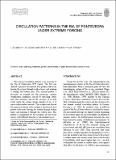Por favor, use este identificador para citar o enlazar a este item:
http://hdl.handle.net/10261/26581COMPARTIR / EXPORTAR:
 SHARE
BASE SHARE
BASE
|
|
| Visualizar otros formatos: MARC | Dublin Core | RDF | ORE | MODS | METS | DIDL | DATACITE | |

| Título: | Circulation Patterns in the Ria of Pontevedra under Extreme Forcing |
Autor: | Álvarez, I.; Gómez-Gesteira, Moncho; Castro, Maite de; Prego, R. CSIC ORCID | Palabras clave: | Wind Upwelling Stratification Positive tidal circulation Negative tidal circulation Galician estuary |
Fecha de publicación: | 2003 | Editor: | Universidad de Vigo | Citación: | Thalassas 19(2): 55-63 (2003) | Resumen: | Two unusual circulation patterns were measured in the Ria of Pontevedra (NW Spain). The first one showed a positive two layered tidal pattern with water leaving the estuary through surface layers and entering it through the bottom ones. This unusual pattern is observed to depend on the particular summer stratification conditions, caused by upwelling events and solar radiation, and on the presence of easterly winds inside the estuary strong enough (~8 m s-1) to move surface water seawards. The second event showed the opposite behavior with a negative two layered tidal pattern with water leaving the estuary through bottom layers and entering it through the surface ones. This pattern is maintained by the existence of two water masses with different densities at intermediate layers. | Descripción: | 9 pages, 11 figures. | Versión del editor: | http://webs.uvigo.es/thalassas/thalassas_marco%20principal.htm | URI: | http://hdl.handle.net/10261/26581 | ISSN: | 0212-5919 |
| Aparece en las colecciones: | (IIM) Artículos |
Ficheros en este ítem:
| Fichero | Descripción | Tamaño | Formato | |
|---|---|---|---|---|
| Thalassas19(2)paper_6.pdf | 438,13 kB | Adobe PDF |  Visualizar/Abrir |
CORE Recommender
Page view(s)
279
checked on 16-abr-2024
Download(s)
140
checked on 16-abr-2024
Google ScholarTM
Check
NOTA: Los ítems de Digital.CSIC están protegidos por copyright, con todos los derechos reservados, a menos que se indique lo contrario.
